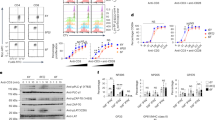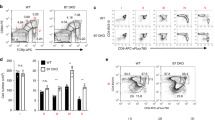Abstract
The T cell antigen receptor (TCR)-CD3 complex is unique in having ten cytoplasmic immunoreceptor tyrosine-based activation motifs (ITAMs). The physiological importance of this high TCR ITAM number is unclear. Here we generated 25 groups of mice expressing various combinations of wild-type and mutant ITAMs in TCR-CD3 complexes. Mice with fewer than seven wild-type CD3 ITAMs developed a lethal, multiorgan autoimmune disease caused by a breakdown in central rather than peripheral tolerance. Although there was a linear correlation between the number of wild-type CD3 ITAMs and T cell proliferation, cytokine production was unaffected by ITAM number. Thus, high ITAM number provides scalable signaling that can modulate proliferation yet ensure effective negative selection and prevention of autoimmunity.
This is a preview of subscription content, access via your institution
Access options
Subscribe to this journal
Receive 12 print issues and online access
$209.00 per year
only $17.42 per issue
Buy this article
- Purchase on Springer Link
- Instant access to full article PDF
Prices may be subject to local taxes which are calculated during checkout





Similar content being viewed by others
References
Daeron, M. Fc receptor biology. Annu. Rev. Immunol. 15, 203–234 (1997).
Reth, M. Antigen receptor tail clue. Nature 338, 383–384 (1989).
Weiss, A. T cell antigen receptor signal transduction: a tale of tails and cytoplasmic protein-tyrosine kinases. Cell 73, 209–212 (1993).
Dal Porto, J.M. et al. B cell antigen receptor signaling 101. Mol. Immunol. 41, 599–613 (2004).
Hamerman, J.A. & Lanier, L.L. Inhibition of immune responses by ITAM-bearing receptors. Sci. STKE 2006, re1 (2006).
Love, P.E. & Shores, E.W. ITAM multiplicity and thymocyte selection: how low can you go? Immunity 12, 591–597 (2000).
Pitcher, L.A. & van Oers, N.S. T-cell receptor signal transmission: who gives an ITAM? Trends Immunol. 24, 554–560 (2003).
Call, M.E. & Wucherpfennig, K.W. The T cell receptor: critical role of the membrane environment in receptor assembly and function. Annu. Rev. Immunol. 23, 101–125 (2005).
Szymczak, A. et al. Correction of multi-gene deficiency in vivo using a single 'self-cleaving' 2A peptide-based retroviral vector. Nat. Biotechnol. 22, 589–594 (2004).
Wang, B. et al. T lymphocyte development in the absence of CD3ε or CD3γδζε. J. Immunol. 162, 88–94 (1999).
Holst, J. et al. Generation of T cell receptor retrogenic mice. Nat. Protocols 1, 406–417 (2006).
Love, P.E., Lee, J. & Shores, E.W. Critical relationship between TCR signaling potential and TCR affinity during thymocyte selection. J. Immunol. 165, 3080–3087 (2000).
van Oers, N.S., Love, P.E., Shores, E.W. & Weiss, A. Regulation of TCR signal transduction in murine thymocytes by multiple TCR ζ-chain signaling motifs. J. Immunol. 160, 163–170 (1998).
Ardouin, L. et al. Crippling of CD3-zeta ITAMs does not impair T cell receptor signaling. Immunity 10, 409–420 (1999).
Lin, S.Y., Ardouin, L., Gillet, A., Malissen, M. & Malissen, B. The single positive T cells found in CD3-ζ/η−/− mice overtly react with self-major histocompatibility complex molecules upon restoration of normal surface density of T cell receptor-CD3 complex. J. Exp. Med. 185, 707–715 (1997).
Robinson, W.H. et al. Autoantigen microarrays for multiplex characterization of autoantibody responses. Nat. Med. 8, 295–301 (2002).
Tusher, V.G., Tibshirani, R. & Chu, G. Significance analysis of microarrays applied to the ionizing radiation response. Proc. Natl. Acad. Sci. USA 98, 5116–5121 (2001).
Aifantis, I., Gounari, F., Scorrano, L., Borowski, C. & von, B.H. Constitutive pre-TCR signaling promotes differentiation through Ca2+ mobilization and activation of NF-κB and NFAT. Nat. Immunol. 2, 403–409 (2001).
Azzam, H.S. et al. CD5 expression is developmentally regulated by T cell receptor (TCR) signals and TCR avidity. J. Exp. Med. 188, 2301–2311 (1998).
Huseby, E.S. et al. How the T cell repertoire becomes peptide and MHC specific. Cell 122, 247–260 (2005).
Maloy, K.J. & Powrie, F. Regulatory T cells in the control of immune pathology. Nat. Immunol. 2, 816–822 (2001).
von Boehmer, H. Mechanisms of suppression by suppressor T cells. Nat. Immunol. 6, 338–344 (2005).
Banham, A.H., Powrie, F.M. & Suri-Payer, E. FOXP3+ regulatory T cells: current controversies and future perspectives. Eur. J. Immunol. 36, 2832–2836 (2006).
Sakaguchi, S. et al. Immunologic tolerance maintained by CD25+CD4+ regulatory T cells: their common role in controlling autoimmunity, tumor immunity, and transplantation tolerance. Immunol. Rev. 182, 18–32 (2001).
Shevach, E.M. et al. The lifestyle of naturally occurring CD4+CD25+ Foxp3+ regulatory T cells. Immunol. Rev. 212, 60–73 (2006).
Xystrakis, E., Boswell, S.E. & Hawrylowicz, C.M. T regulatory cells and the control of allergic disease. Expert Opin. Biol. Ther. 6, 121–133 (2006).
Coombes, J.L., Robinson, N.J., Maloy, K.J., Uhlig, H.H. & Powrie, F. Regulatory T cells and intestinal homeostasis. Immunol. Rev. 204, 184–194 (2005).
Brunkow, M.E. et al. Disruption of a new forkhead/winged-helix protein, scurfin, results in the fatal lymphoproliferative disorder of the scurfy mouse. Nat. Genet. 27, 68–73 (2001).
Fontenot, J.D., Gavin, M.A. & Rudensky, A.Y. Foxp3 programs the development and function of CD4+CD25+ regulatory T cells. Nat. Immunol. 4, 330–336 (2003).
Anderson, M.S. et al. Projection of an immunological self shadow within the thymus by the aire protein. Science 298, 1395–1401 (2002).
Zucchelli, S. et al. Defective central tolerance induction in NOD mice: genomics and genetics. Immunity 22, 385–396 (2005).
Holst, J., Vignali, K.M., Burton, A.R. & Vignali, D.A. Rapid analysis of T-cell selection in vivo using T cell-receptor retrogenic mice. Nat. Methods 3, 191–197 (2006).
Valujskikh, A., Lantz, O., Celli, S., Matzinger, P. & Heeger, P.S. Cross-primed CD8+ T cells mediate graft rejection via a distinct effector pathway. Nat. Immunol. 3, 844–851 (2002).
Schonrich, G. et al. Down-regulation of T cell receptors on self-reactive T cells as a novel mechanism for extrathymic tolerance induction. Cell 65, 293–304 (1991).
Yamazaki, T. et al. A shift from negative to positive selection of autoreactive T cells by the reduced level of TCR signal in TCR-transgenic CD3 ζ-deficient mice. J. Immunol. 158, 1634–1640 (1997).
Shores, E.W. et al. T cell development in mice lacking all T cell receptor ζ family members (ζ, η, and FcεRIγ). J. Exp. Med. 187, 1093–1101 (1998).
Yu, Q. et al. Cytokine signal transduction is suppressed in preselection double-positive thymocytes and restored by positive selection. J. Exp. Med. 203, 165–175 (2006).
Hasler, P. & Zouali, M. Immune receptor signaling, aging, and autoimmunity. Cell. Immunol. 233, 102–108 (2005).
Nambiar, M.P. et al. Reconstitution of deficient T cell receptor ζ chain restores T cell signaling and augments T cell receptor/CD3-induced interleukin-2 production in patients with systemic lupus erythematosus. Arthritis Rheum. 48, 1948–1955 (2003).
Sakaguchi, N. et al. Altered thymic T-cell selection due to a mutation of the ZAP-70 gene causes autoimmune arthritis in mice. Nature 426, 454–460 (2003).
Takeuchi, T. et al. TCR ζ chain lacking exon 7 in two patients with systemic lupus erythematosus. Int. Immunol. 10, 911–921 (1998).
Tsuzaka, K., Takeuchi, T., Onoda, N., Pang, M. & Abe, T. Mutations in T cell receptor ζ chain mRNA of peripheral T cells from systemic lupus erythematosus patients. J. Autoimmun. 11, 381–385 (1998).
Strober, W. & Ehrhardt, R.O. Chronic intestinal inflammation: an unexpected outcome in cytokine or T cell receptor mutant mice. Cell 75, 203–205 (1993).
Pitcher, L.A. et al. The CD3γε/δε signaling module provides normal T cell functions in the absence of the TCR ζ immunoreceptor tyrosine-based activation motifs. Eur. J. Immunol. 35, 3643–3654 (2005).
Ho, W.Y., Cooke, M.P., Goodnow, C.C. & Davis, M.M. Resting and anergic B cells are defective in CD28-dependent costimulation of naive CD4+ T cells. J. Exp. Med. 179, 1539–1549 (1994).
Szymczak, A. & Vignali, D.A.A. Development of 2A peptide-based strategies in the design of multicistronic vectors. Expert Opin. Biol. Ther. 5, 627–638 (2005).
Szymczak-Workman, A.L., Vignali, K.M. & Vignali, D.A.A. in Gene Transfer: Delivery and Expression (eds. Friedmann, T. & Rossi, J.) 137–147 (Cold Spring Harbor Laboratory Press, Cold Spring Harbor, New York, 2006).
Markowitz, D., Goff, S. & Bank, A. A safe packaging line for gene transfer: separating viral genes on two different plasmids. J. Virol. 62, 1120–1124 (1988).
Persons, D.A. et al. Retroviral-mediated transfer of the green fluorescent protein gene into murine hematopoietic cells facilitates scoring and selection of transduced progenitors in vitro and identification of genetically modified cells in vivo. Blood 90, 1777–1786 (1997).
Persons, D.A., Mehaffey, M.G., Kaleko, M., Nienhuis, A.W. & Vanin, E.F. An improved method for generating retroviral producer clones for vectors lacking a selectable marker gene. Blood Cells Mol. Dis. 24, 167–182 (1998).
Acknowledgements
We thank D. Green, M. Davis and J. Ihle for reviewing the manuscript; L. Collison (St. Jude Children's Research Hospital) for mice with inflammatory bowel disease; C. Terhorst (Harvard Medical School) for Cd3eΔP/ΔP mice; N. van Oers (University of Texas Southwestern Medical Center) for CD3ζ-KO Tg1-6M mice; M. Davis for 3A9 TCR–transgenic mice; K. Vignali, Y. Wang, S. Dilioglou, A. Burton and E. Vincent for technical assistance; the Vignali lab for assistance with bone marrow collection; R. Cross, J. Hoffrage, J. Smith and Y. He for flow cytometry; S. Rowe, J. Gatewood and J. Smith for cytokine analysis; L. Zhang of the Cell and Tissue Imaging facility for image acquisition; the staff of the Flow Cytometry and Cell Sorting Shared Resource facility for purification by magnetic-activated cell sorting; and the Hartwell Center for DNA sequencing. Supported by the National Institutes of Health (AI-52199; and U19-DK-6134 to P.J.U.), the St. Jude National Cancer Institute Cancer Center (CA-21765) and the American Lebanese Syrian Associated Charities (D.A.A.V.) the National Heart, Lung and Blood Institute (proteomics contract NOI-HV-28183 to P.J.U.); and the Floren Family Trust (P.J.U.).
Author information
Authors and Affiliations
Contributions
All authors contributed to discussions of experimental design, data analysis and/or editing of the manuscript; J.H. did all experiments unless stated otherwise; H.W., K.D.E. and C.J.W. generated mice for the immunofluorescence microscopy and autoantibody analysis, did the Treg cell experiments, chimera-lymphopenia experiments, some of the flow cytometry analysis and the BrdU and lymph node assays; K.L.B. did all the histological analysis and scoring while 'blinded' to sample identity; K.F. assisted in cellular isolation and analysis and managed the breeding colonies; Z.B. and R.S. did the immunofluorescence microscopy, H.S., A.C. and P.J.U. did the autoantibody analysis; N.S.C.v.O. provided the CD3ζ-KO Tg1-6M-transgenic mice and discussions about their use; J.H. and D.A.A.V. wrote the manuscript; and D.A.A.V. conceptualized and directed the project.
Corresponding author
Supplementary information
Supplementary Text and Figures
Supplementary Results, Supplementary Methods, Supplementary Tables 1–3 and Supplementary Figures 1–13 (PDF 2235 kb)
Rights and permissions
About this article
Cite this article
Holst, J., Wang, H., Eder, K. et al. Scalable signaling mediated by T cell antigen receptor–CD3 ITAMs ensures effective negative selection and prevents autoimmunity. Nat Immunol 9, 658–666 (2008). https://doi.org/10.1038/ni.1611
Received:
Accepted:
Published:
Issue Date:
DOI: https://doi.org/10.1038/ni.1611
This article is cited by
-
Who wins the combat, CAR or TCR?
Leukemia (2023)
-
Harnessing CD3 diversity to optimize CAR T cells
Nature Immunology (2023)
-
Reversal of the T cell immune system reveals the molecular basis for T cell lineage fate determination in the thymus
Nature Immunology (2022)
-
Differential gene expression analysis of ankylosing spondylitis shows deregulation of the HLA-DRB, HLA-DQB, ITM2A, and CTLA4 genes
Egyptian Journal of Medical Human Genetics (2021)
-
BW5147 and Derivatives for the Study of T Cells and their Antigen Receptors
Archivum Immunologiae et Therapiae Experimentalis (2020)



